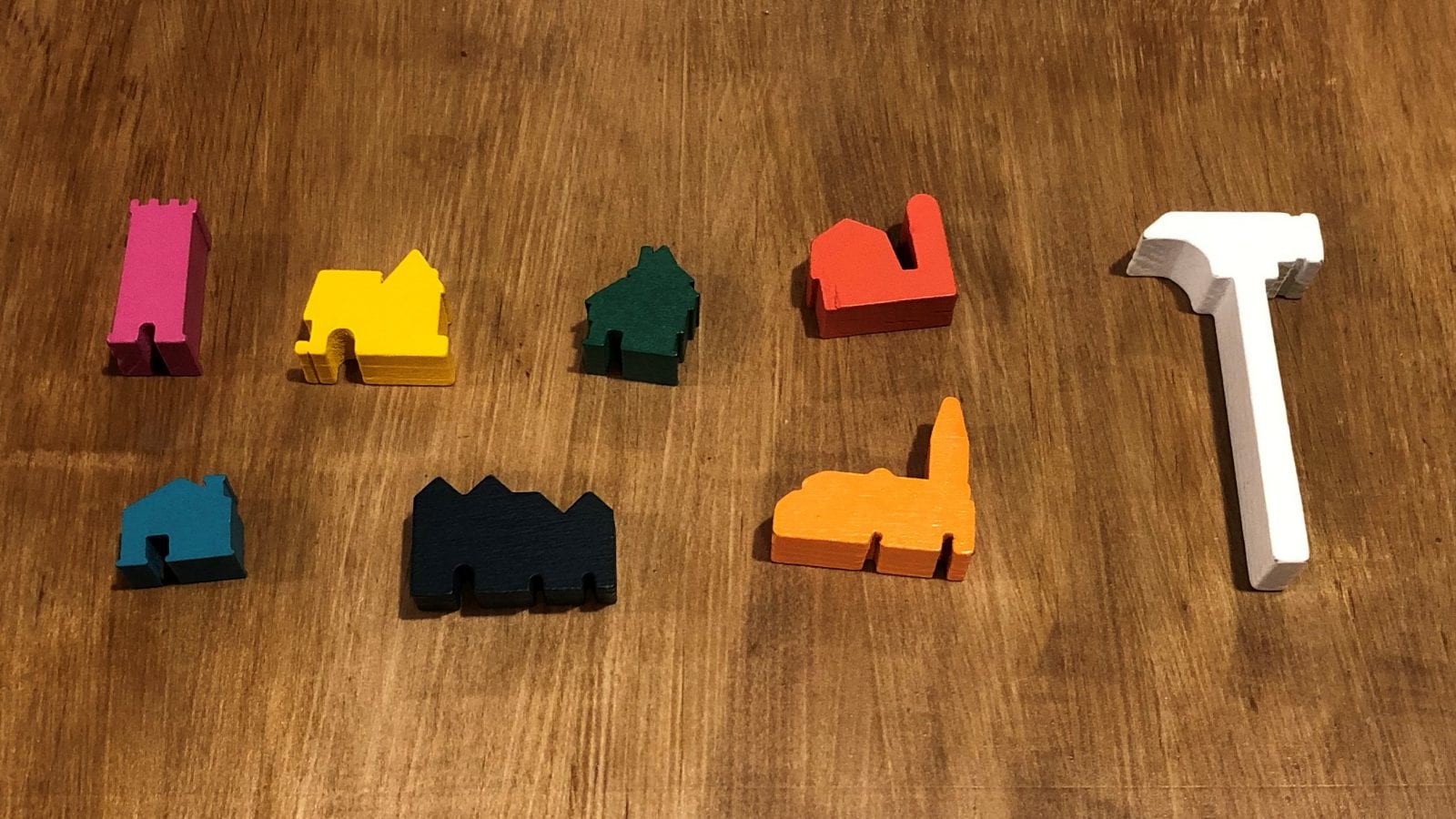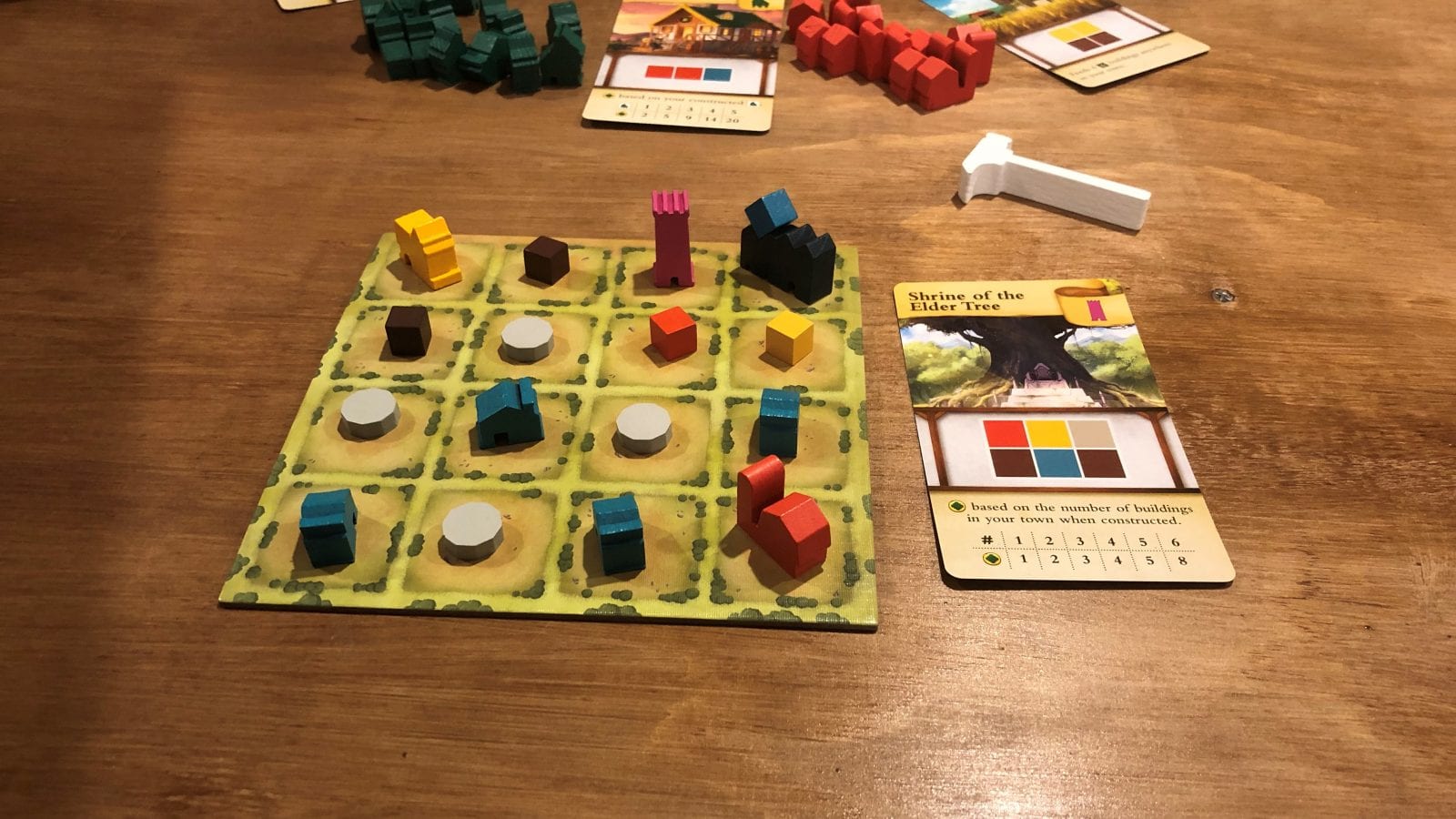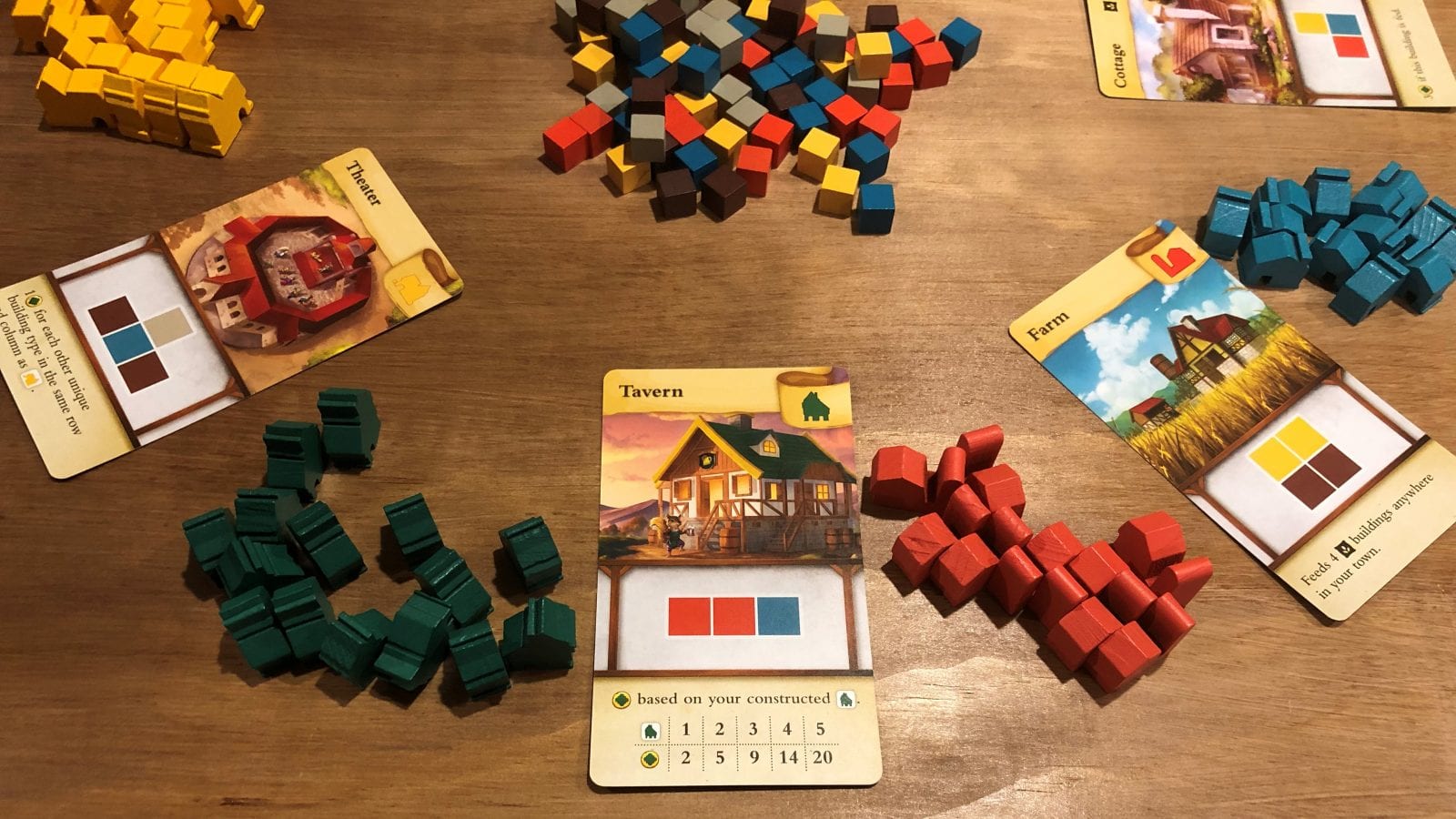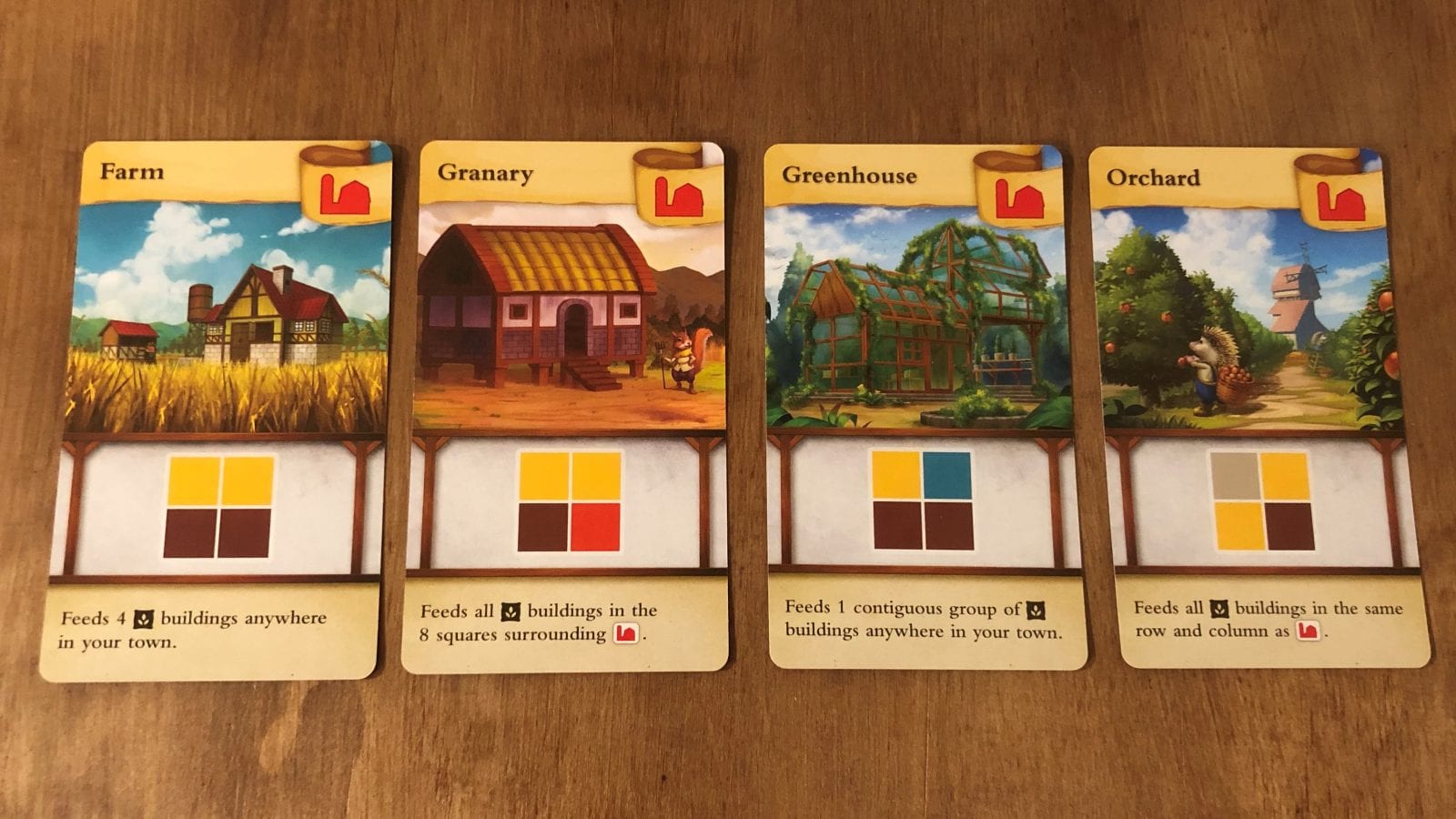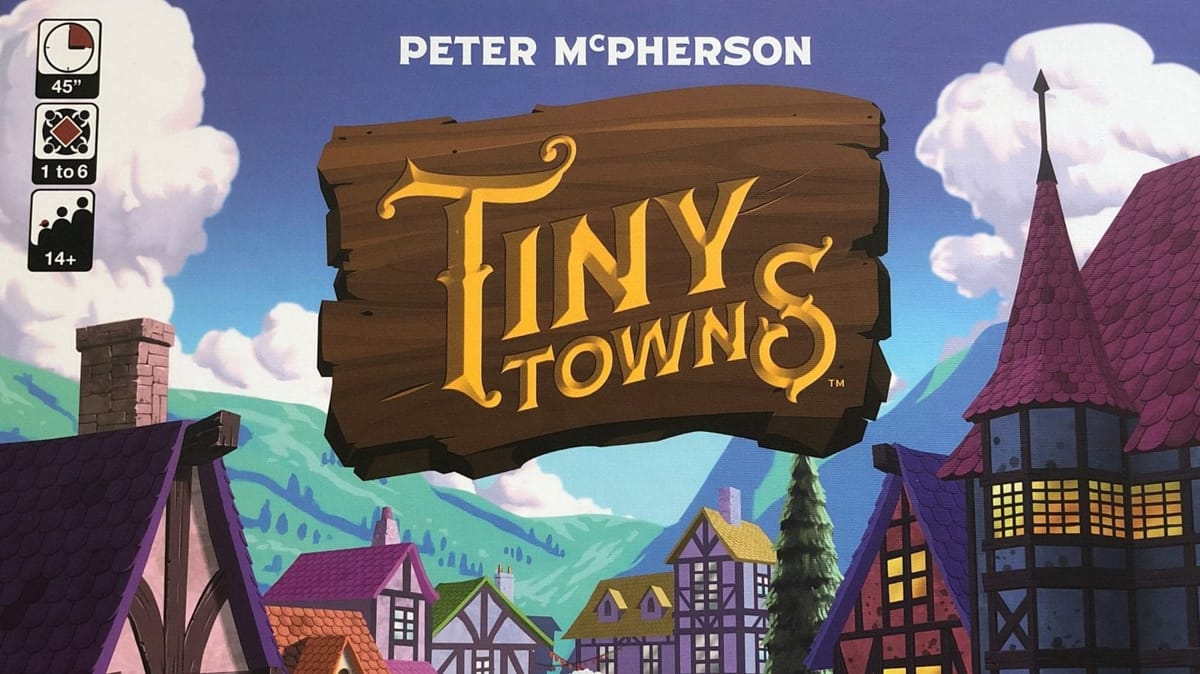
Cute little animals need a place to live! That’s right, tiny animals have decided to build a small town hidden away from predators in the woods and you are the mayor that needs to guide them through it. Resources are not plentiful, so you have to build with what you can get when you get it. This tricky board game will test your planning skills as your brain melts in your skull trying to figure out the optimal placement of resources and buildings. Tiny Towns, designed by Peter McPherson and published by AEG, is a puzzling abstract strategy game that puts a player’s flexibility and planning skills to the test.
When you crack open the Tiny Towns box, you get six player boards, a bunch of wooden resource cubes, a pile of wooden building meeples, lots of cards, a pad of scoresheets, and a small wooden hammer. The player boards show green fields divided into four-by-four grids, so each player has sixteen squares in which they will build their tiny town. The resource cubes are your standard colored wooden cubes representing five different resources that are used to build buildings: wood; wheat; brick; stone; and glass. The wooden buildings represent eight different types of buildings that are built in tiny animal towns. The buildings represent the basic themes of cottages, chapels, farms, taverns, wells, theaters, and factories — their type is easy to determine by their distinct shape and color. The cards are divided into building cards, monument cards, and resource cards.
Building cards, used in every game, show the name of the building, a whimsical image depicting what the building looks like when tiny animals build them, a colored shape that matches the distinct shape and color of a wooden building token, the arrangement and type of resources needed to build it, and scoring information for that building. Monument cards look and work just like building cards and are used in most games, except when a new player is trying to figure out the game. The resource deck are cards that represent resources; they are used in a multiplayer variant of the game and in the solo variant. The colorful score sheets are helpful in totaling scores at the end of the game. The wooden hammer meeple, called the Master Builder hammer, is a two-inch, white, wooden hammer that players will want to use to tap on things. The art style and theme are fun and the components are attractive and make sense. With all those components on the table and the rulebook too, people are all set to build tiny towns for animals.
The rulebook is well laid out and only eight pages long, making reading through the rules a breeze. Basic gameplay is simple and easy to learn. In the center of the table goes a face up Cottage card that represents the cottages each player will build. The Cottage cards are the only cards that are guaranteed to be the same in every game – animals have to have a place to live in their tiny town, after all. Then six more building cards, one for each type of distinct building, are randomly dealt face up next to the Cottage card. While the Cottage card is the same every game, the six other building cards have four variations that change what their matching buildings represent. Each building card type is thematically similar to its base building, but they all function slightly differently. For instance, the four farm building cards are titled, Farm, Granary, Orchard, and Greenhouse. Each card requires a different combination of resources to build the building and each building has a slightly different effect on scoring, but all of them have to do with providing food to buildings that need food. The seven building cards that are laid out in the center of the table stay in play for the whole game and dictate what the buildings represent when built in a player’s tiny town. Each player is dealt two monument cards and they choose the one they want to keep for the game, which they keep face down and work towards secretly. Throughout the game, players can build as many of the buildings as they want and are able, except their monument, which they can only build once. The resource cards only come into play in variant play and are used to produce random resources depending on the variant being played.
Every round, a player called the Master Builder (who holds the Master Builder Hammer) selects a resource type and places it in one of the available squares on their player board. Simultaneously, every other player also takes one of the same resources from the stockpile and places it in one of the available squares on their own player board. Once placed, resources cannot be moved to different squares on the player board, and only one resource can go in a square at a time. Also, resources cannot go into spaces that have buildings in them, so as the game develops, the number of available squares dwindles. The Master Builder Hammer is passed to the next player at the end of each round of play, giving each player an opportunity to select a resource that suits their needs. During each round of play, after selecting a resource, players may then simultaneously build buildings if they want.
To build a building, players need to have resources allocated on their player board in the shape and color pattern that is shown on the corresponding building card in the center of the table. Shapes can be flipped and rotated but the color pattern has to match. For example, to build a farm, you have to have two wood side by side and two wheat wide by side stacked in a square. As long as you have a square with that pattern of resources regardless of rotation, you can use those resources to place the building; if the resources aren’t in a square, or the pattern doesn’t match (the wheat and wood are diagonal rather than side by side), then you cannot build that building with those resources.
When you build the building, you pick up the resources from your player board that make up the qualifying pattern for that building, then place a corresponding building token on any one of the squares that those resources came from. So in the farm example, after you identify two wood and two wheat in the correct pattern on your player board, then you pick up those resources and return them to the resource pile, then put a farm building on any of the four squares that the resources just came from. That’s it: you place resources in patterns, remove resources to place buildings, and at the end of the game, you get points based on the buildings you built.
But, that’s not it, really. Once you sit down with a player board and a group of fun-loving animal architects the real brain burn starts. Initially, when you are dealing with an empty grid of sixteen spacious plots of land, things are easy and the future looks rosy. But, that’s when you have room to play. That situation does not last long. In the first few rounds as you start putting down resources, you need to think about what buildings you want to build and where. Each time you finally accumulate enough resources in the proper shape and build a building, you free up all but one of the squares that the resources were in. So, every building you build scores you more points at the end of the game, but also takes away one of the spaces you need to lay out resources in patterns. Once three or four buildings are in your tiny town, the squares that your buildings are taking up can really affect your ability to match the patterns you need to build buildings. For instance, the Factory card requires you to have five resources in an ‘L’ pattern, four straight across (one brick, then two stone, then another brick) then one on the foot of the ‘L’ (a wood). To build the factory then, you must have four squares available straight across your town — once you build a building in every horizontal row of your town, you will no longer have the option of building Factories by laying the pattern out horizontally. This would all be hard enough if you were always choosing which resource you want each round, but that’s not the case! The Master Builder chooses. Remember, the Master Builder role rotates every turn, so each player only has control of the resource selection periodically. What this means is, while you may have a grand strategy for what you want your town to look like, you have to adjust tactically throughout the game to utilize the resources that are handed to you when you are not the Master Builder. When a player’s town is stuffed with resources and they cannot (or will not) build any more buildings they are done, they stop playing and start adding up their score. Everyone else continues to play until each is done and starts adding up their scores. Everyone compares scores and the highest score wins. So that’s it: you place resources in patterns on an ever-shrinking field, remove resources to place buildings that may not be the ones you wanted to play, and at the end of the game, you get points based on the buildings you built.
But that’s still not it, really: The number of players definitely changes the play of the game. With the role of Master Builder rotating, in a two-player game you control the resource you get half of the time, but in a six-player game you are in control one sixth of the time. That can be super frustrating if your opponents are all thinking of weird strategies and you just want to build a cottage. If all you need is one wheat for your cottage but the other four players take a stone, a glass, and two wood before your turn, then you might end up having to build a theater before you finally select that wheat and build your tiny animal cottage. Having more players makes it more challenging, but not impossible. A lot of the time, at least one or two of your opponents will be building the same thing you are, so the resources you are getting on your opponent’s turns are not totally random. And, since everyone is building most of their town from the same seven building cards in the center of the table, you will generally find a use for each resource you get. However, each player is also building a monument that is secret and different from everyone else’s. The monuments tend to have complicated patterns and a variety of resources, so monument construction can have players selecting resources that other players might not have a use for in their plans. While you might want to build a specific building, you are likely to be handed resources that aren’t part of that building’s pattern, so you’ll need to put those elsewhere in your town while you continue to work toward the building you want. You have to be flexible and modify your strategy as you go along, using the resources available to plan out and build as best you can.
There are two variants of the game, Town Hall and Solo. Both variants use the same general rules of play and have the same end state — a Tiny Town full of tiny buildings and resources. The Town Hall variant of the game uses resource cards to randomize some of the resource selection. In this variant of the game there is no Master Builder, instead, a card is drawn from the resource deck to generate a random resource that everyone must take. Random resources are generated for two turns, then players choose a resource on their own. The pattern repeats, which means that in this variation of the game, each player is selecting their own resource one third of the time. It’s similar to resource selection in the three-player game, but two of the resources are truly random, so you could end up with a lot of resources you don’t want or need, but everyone else is in the same boat. In the Solo variant, the resource cards are used to provide a single player with a set of three random resources to choose from each turn. Solo players are shooting for a high score. Both variants are easy to implement and just as challenging as the base game.
Scoring in Tiny Towns is a complicated process. Each building scores you points at the end of the game based on its type, with the way it scores described on the card. For instance, cottages (the only building consistent in every game) score three points each if they are “fed”. Farms provide food to four buildings that need to be fed, so if you have just one farm but six cottages, you only get points for the four cottages the farm feeds (12 points). Chapels give you one point for each fed cottage, so in the previous example, if you had one chapel built, you’d get four more points for the four fed cottages. Wells give you one point for each adjacent cottage. Taverns give you more points for each tavern built. Theaters give you points for each unique building in the same row and column that they are in. Factories don’t give you any points but allow you more control over the resources you select. So, in the starter game using the recommended starter buildings, players will want at least four cottages, built around a well, with a farm, a bunch of taverns and chapels all built in rows and columns that maximize the points for the theater — and maybe a factory. And that’s just the recommended starter set, don’t forget that there are three other variations of each card (except cottages), and a pile of monuments, all with their own scoring conditions or resource handling effects.
To illustrate how much the variation between building types can affect game play and scoring, look at the Farm-type building cards. There are four: the basic Farm; the Granary; the Greenhouse; and the Orchard. To build them, they each require four resources in a square pattern, but the resources vary from card to card. So while the shape remains the same, to build a Farm players need two wood and two wheat; building a Granary requires two wheat, one wood, and one brick; for the Greenhouse players need two wood, a wheat, and a glass; and finally, the Orchard takes two wheat, a stone, and a wood. Once built, the scoring is different for each as well. The Farm feeds up to four buildings that need food anywhere on the board. The Granary feeds any buildings that need food in the eight squares surrounding the Granary. The Greenhouse feeds one contiguous group of buildings that need food anywhere on the board. While the Orchard feeds all the buildings that need food in the same row or column that the Orchard is in.
After playing through this game quite a few times, I can say that I am not very good at it. Most people will have to conquer a Tiny Town learning curve that varies in steepness by the individual, but for some like me – the curve is pretty darned steep. At first blush, it’s a fairly simple concept, but in execution, you have to be thinking about a half a dozen different things with each resource selected and where it’s placed, and each building built and where it’s placed. The longer the game goes on, the tighter the Tiny Town gets and the worse your options are. To me, Tiny Towns feels more like solving an increasingly hard puzzle than playing a game. My first game was a perfect storm of mistakes and regrets. Multiple plays later, I started to gain an appreciation for the game, but the appreciation was hard won and all of the games were hard losses. In each play feel like only half of my score is from deliberate actions on my part, and the rest is pure dumb luck.
If you are good at abstract strategy games or puzzles, then you will likely be good at Tiny Towns. If you struggle with them, then Tiny Towns will likely be tougher for you. The nice thing about the Solo Variant is that you can use that to hone your skills and you might get better, then find the game more appealing – practice makes perfect. Similarly, if you are into abstract strategy games or puzzles, then you will very likely dig Tiny Towns. But unlike the skill-side of things, if you aren’t into this type of game, then playing the Solo Variant isn’t likely to change your opinion much.
On the plus side, the randomized buildings give players a reason to come back for another go with a different set of buildings. This variability and replayability makes this a good game for stable rotation in a collection. You can pull this out and play it three or four times in a row and have a different puzzle of buildings to try to jam into your town. No matter the version of the game you play, the monuments are a driving factor behind resource selection and placement, and there are plenty of monuments to keep each play fresh. So, while players may need to learn the game without the monuments in play (they are more complicated to play and score), they are an essential part of the fun and replayability, so make sure to add them in once you’ve got the basics down.
Tiny Towns
Great
Tiny Towns is a great abstract strategy game that challenges players to plan, adjust, and plan again. The learning curve for some may be extremely steep; the variety of building cards makes each play through different, and having a unique monument to build gives players variety and different ways to score points. Solo and Town Hall variants provide players with options to level the playing field and increase skills. All in all, this game is an excellent puzzler that will give your brain a workout! If you like puzzle or abstract games, then this should be in your collection. If you aren't into those games, give it a try anyway; you might be surprised to find you like it!
Pros
- Variable building cards each game
- Challenging gameplay that rewards adaptability
- Easy to learn
Cons
- May be too complicated for some
- Requires multiple plays to get a taste for

